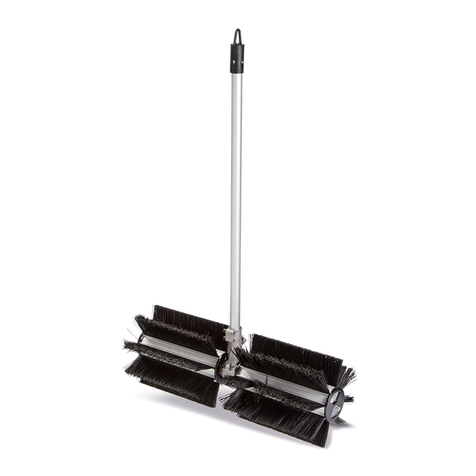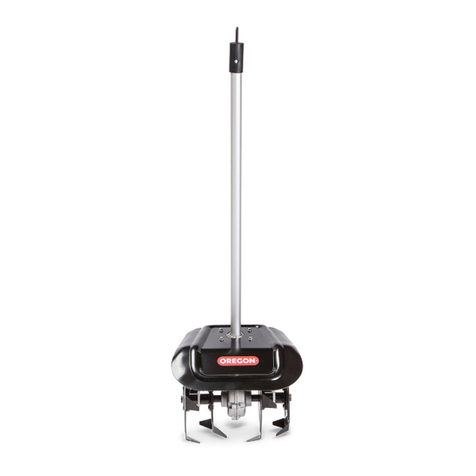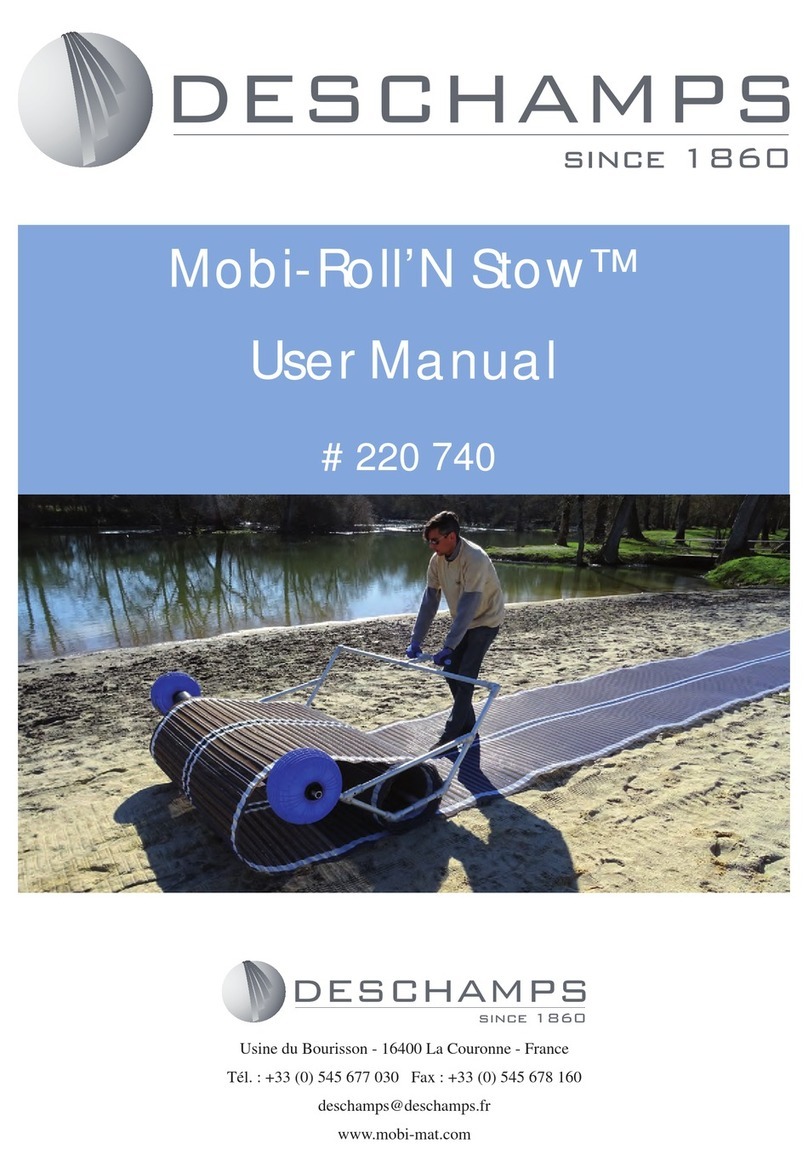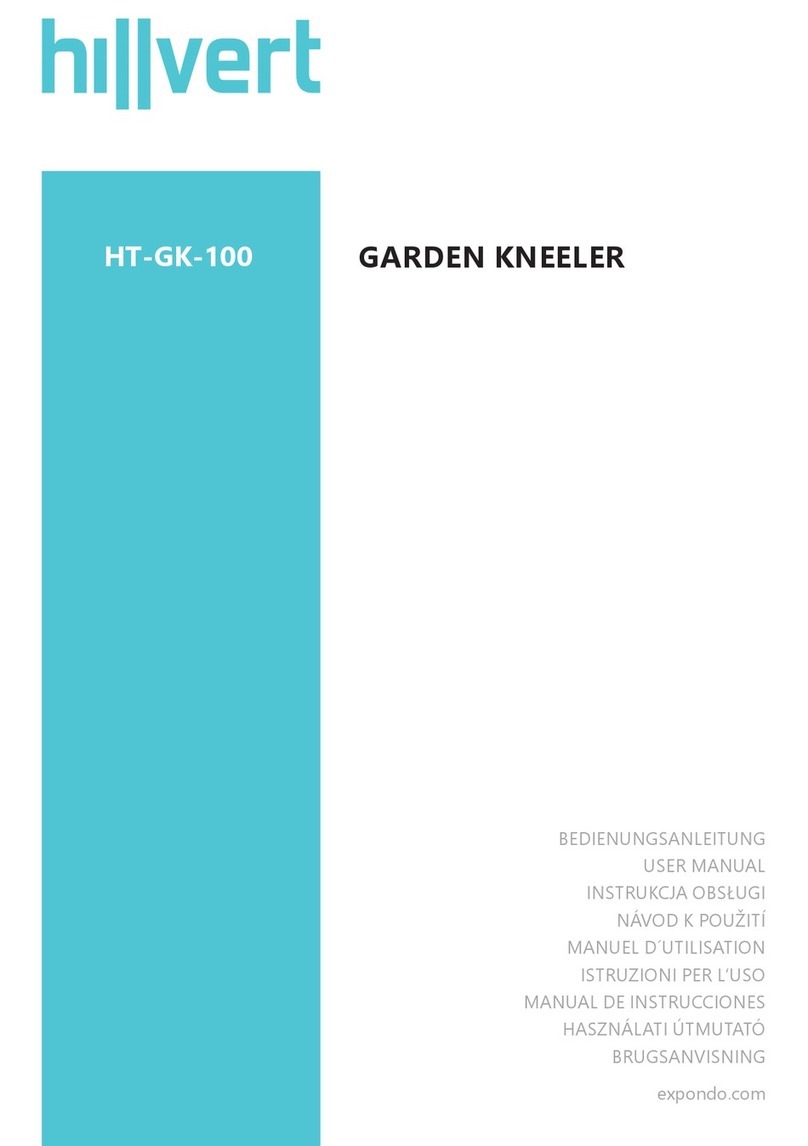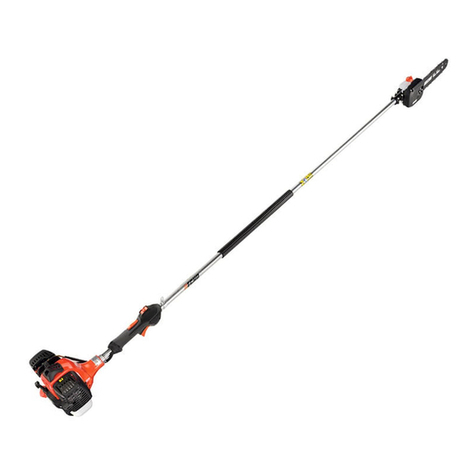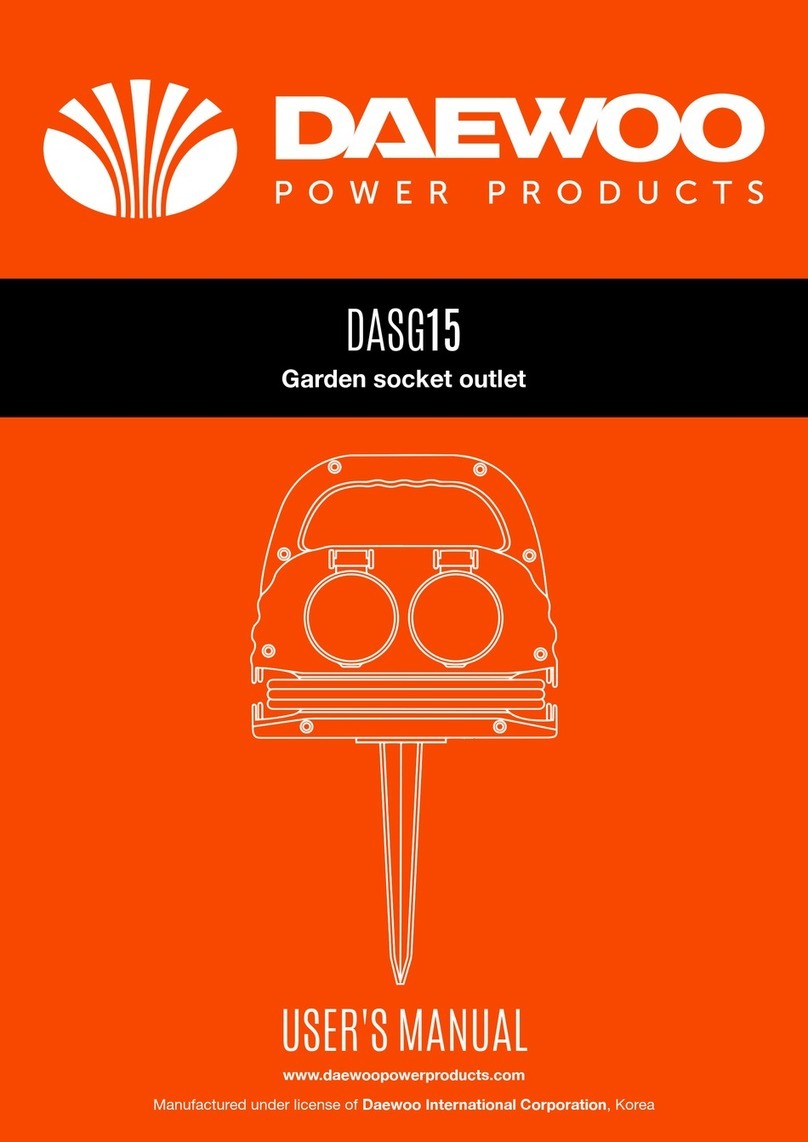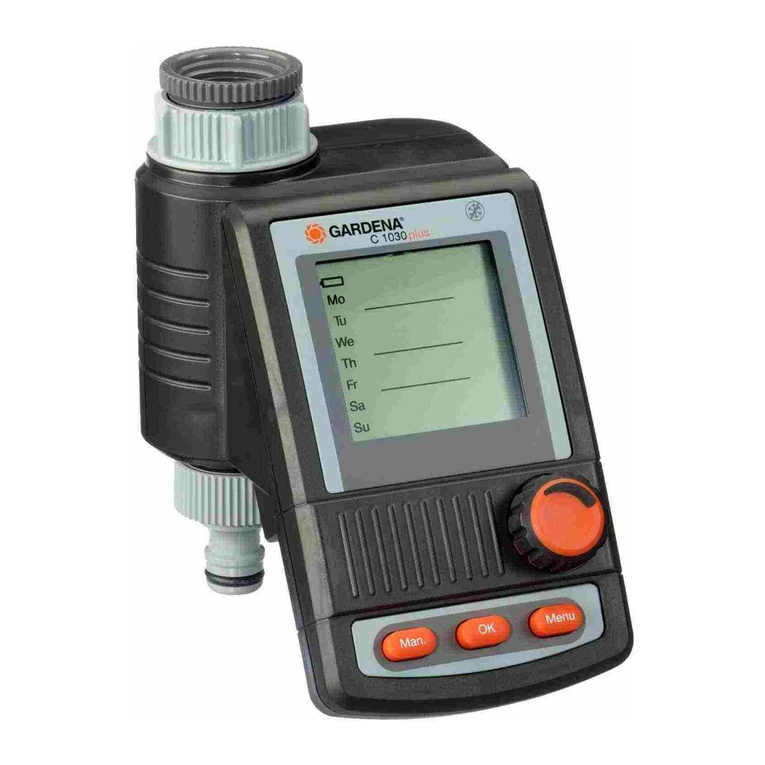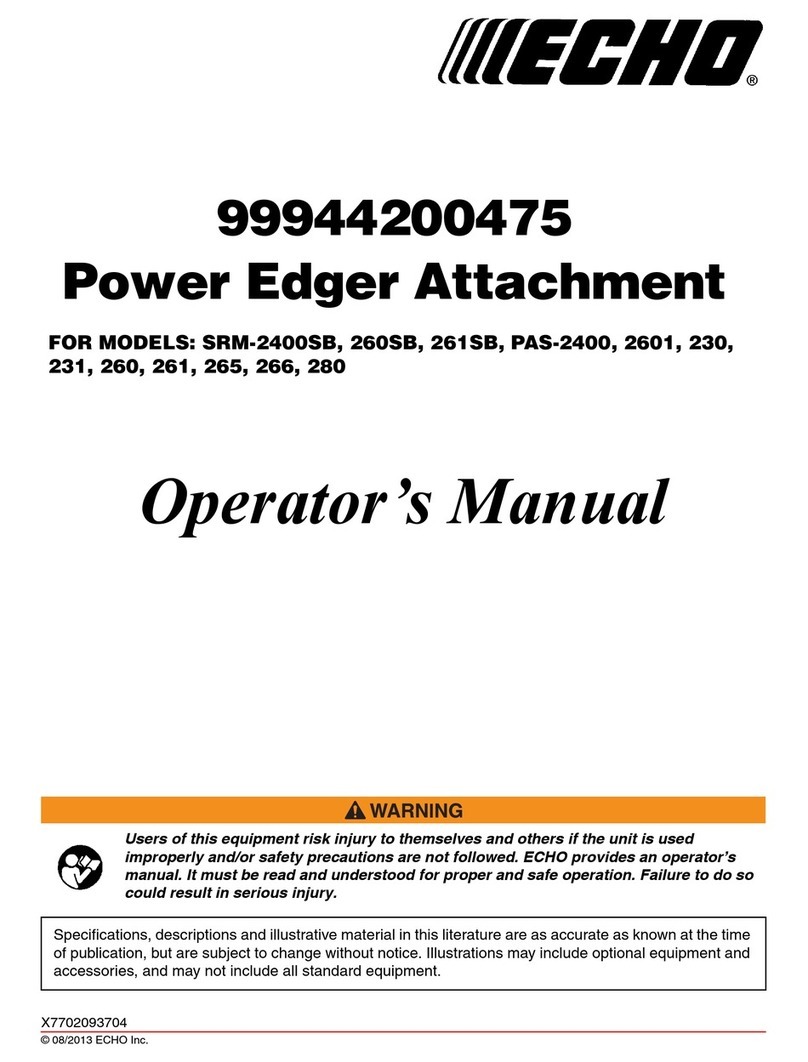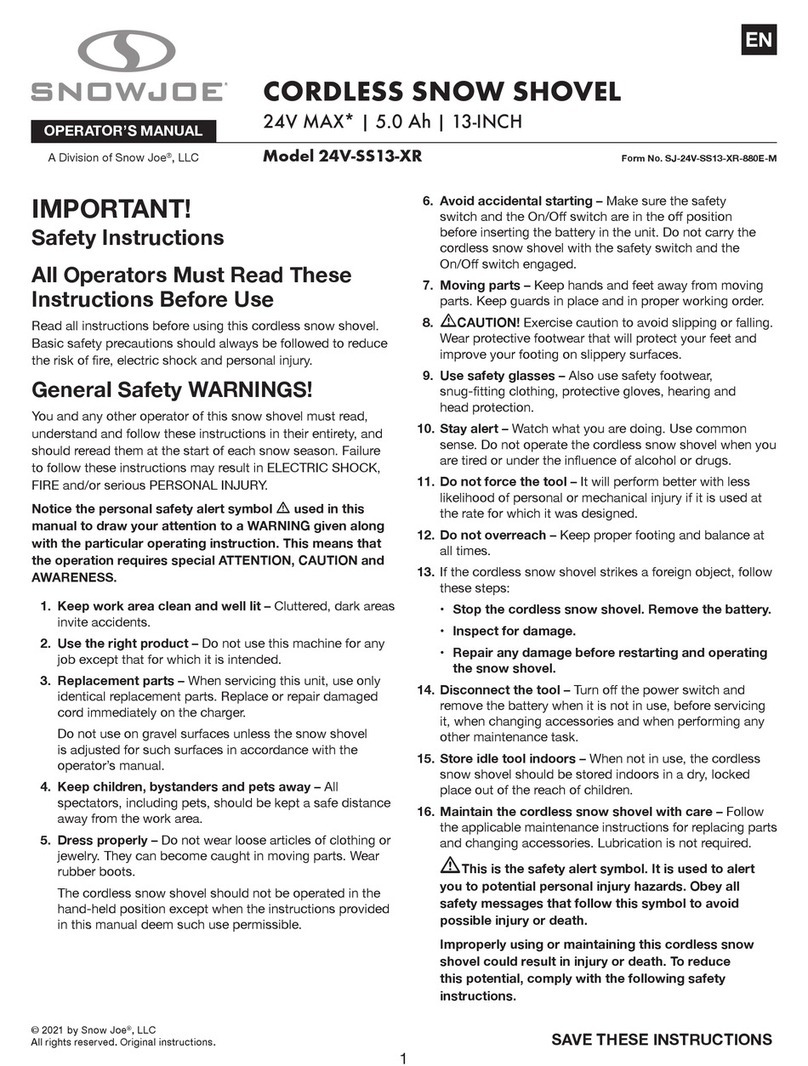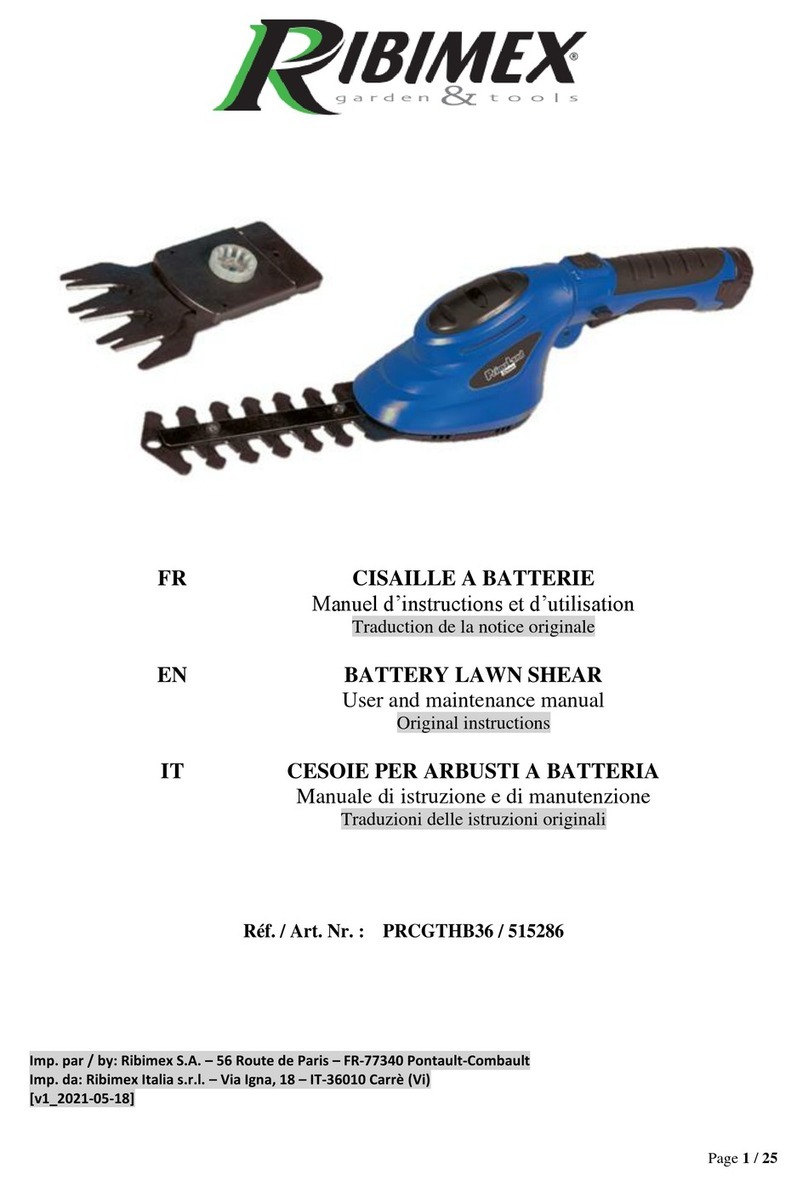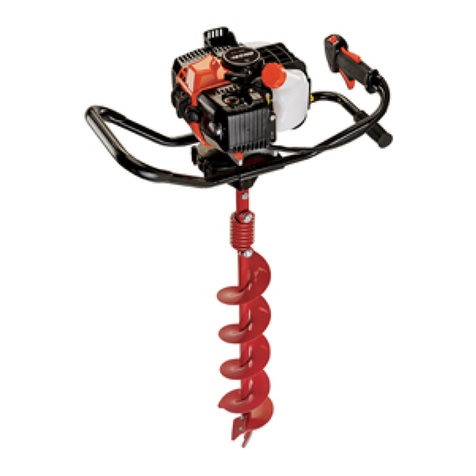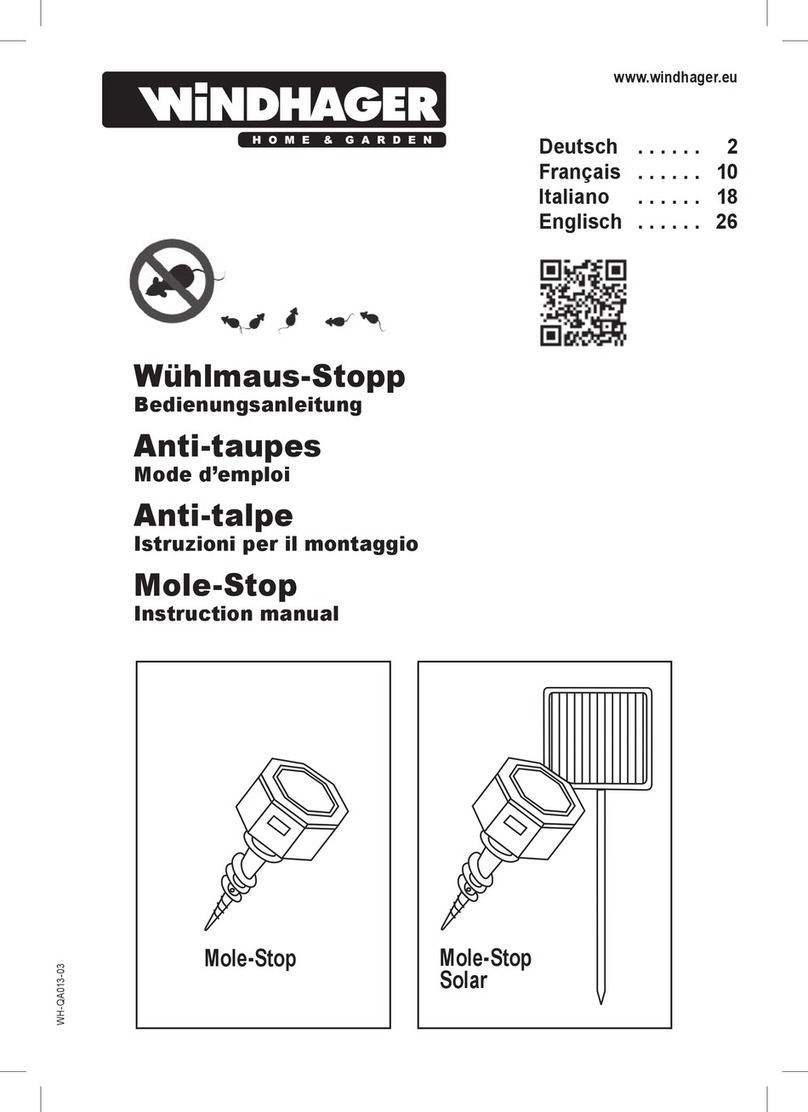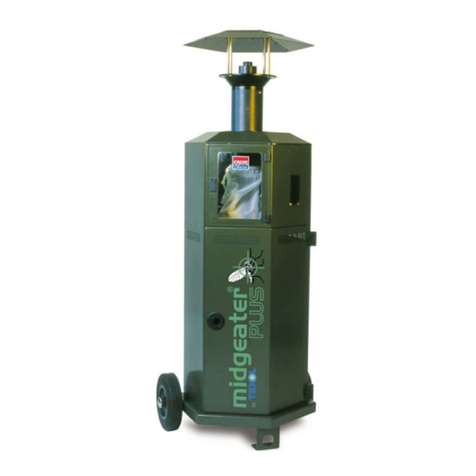Oregon 480RT User guide

OregonProducts.com
ROTARY TILLER
Models 480RT, 600RT and 720RT
Original Instruction Manual

2
INTRODUCTION
Introduction
Read this manual before operating your Oregon equipment. The information presented will prepare you to do
a better and safer job. Keep this manual handy for ready reference. Require all operators to read this manual
carefully and become acquainted with all adjustment and operating procedures before attempting to operate.
Replacement manuals can be obtained from your dealer. To locate your nearest dealer, check the Dealer Locator
at OregonProducts.com, or in the United States and Canada call 1-800-525-8322.
¡LEA EL INSTRUCTIVO! SI NO LEE INGLÉS PIDA AYUDA A ALGUIEN QUE SI LO LEE PARA QUE LE
TRADUSCA LAS MEDIDAS DE SEGURIDAD.
The equipment you have purchased has been carefully engineered and manufactured to provide dependable and satisfactory
use. Like all mechanical products, it will require cleaning and upkeep. Lubricate the unit as specified. Observe all safety
information in this manual and safety decals on the equipment.
This Operator's Manual should be regarded as part of the machine. Suppliers of both new and second-hand machines must
make sure this manual is provided with the machine.
For service, your authorized Oregon dealer has trained mechanics, genuine Oregon service parts, and the necessary tools and
equipment to handle all your needs.
Use only genuine Oregon service parts. Substitute parts will void the warranty and may not meet standards required for safe
and satisfactory operation. Record the model number and serial number of your equipment in the spaces provided:
Serial Number Label Location: See Safety Decal Section
Record the information below for future reference.
Model No _________________________________________________________________________________________
Date of Purchase ___________________________________________________________________________________
Serial No. _________________________________________________________________________________________
Place of Purchase __________________________________________________________________________________
Provide this information to your dealer to obtain correct repair parts.

3
TABLE OF CONTENTS
© Oregon Tool, Inc. Pricing and specifications subject to change without notice.
All rights reserved. Oregon® is a trademark of Oregon Tool, Inc. in the United States and/or in other countries.
Table of Contents
Explanation of Signal Words . . . . . . . . . .4
Specifications . . . . . . . . . . . . . . . . . . .5
General Information . . . . . . . . . . . . . . .5
Safety Rules. . . . . . . . . . . . . . . . . . . .6
Training 6
Preparation 6
Operation 7
Maintenance 8
Storage 8
Safety & Instructional Decals . . . . . . . . . .9
Operation . . . . . . . . . . . . . . . . . . . . 11
Attaching Rotary Tiller To Tractor 11
Driveline Attachment 12
Shortening Driveline 13
Working Depth Adjustment 14
Tiller Offset 14
Operating Procedure 15
Operating Techniques 16
Transportation 16
Storage 16
Pre-Operation Check List 17
Owner Service . . . . . . . . . . . . . . . . . 18
Blocking Method 18
Lubrication Information 19
PTO Drive Lines 19
Qualified Technician Maintenance 19
Cleaning 21
Blade Installation 21
Troubleshooting . . . . . . . . . . . . . . . . 22
Dealer Service . . . . . . . . . . . . . . . . . 23
Gearbox Maintenance 23
Universal Joint Repair 24
Assembly . . . . . . . . . . . . . . . . . . . . 26
Set-Up Instructions 26
Disassemble Shipping Unit 26
Assembly Procedures 26
Parts Index . . . . . . . . . . . . . . . . . . . 28
Oregon 480RT Rotary Tiller Assembly 28
Oregon 600RT & 720RT Rotary Tiller Assembly 30
1042364 Slip Clutch Drive Assembly
480RT Tiller 32
1042365 Slip Clutch Drive Assembly
600RT & 720RT Tillers 33
Tiller Side Drive Assembly 34
1042304 Gearbox Assembly 35
Bolt Torque Chart. . . . . . . . . . . . . . . .36
SAE Series Torque Chart 36
Metric Series Torque Chart 37
Bolt Size Chart . . . . . . . . . . . . . . . . . 38
Abbreviations . . . . . . . . . . . . . . . . . .38
Limited Warranty . . . . . . . . . . . . . . . .39

4
EXPLANATION OF SIGNAL WORDS
Explanation of Signal Words
This section contains safety information for the Oregon Rotary Tiller. Throughout this manual, the terms DANGER, WARNING,
and CAUTION are used in conjunction with the Safety-Alert Symbol (a triangle with an exclamation mark) to indicate the
degree of hazard for items of personal safety. The term NOTICE is used to indicate that failure to observe can cause damage to
equipment.
This is the safety alert symbol. It is used to alert you to potential physical injury hazards.
Obey all safety messages that follow this symbol to avoid possible injury or death.
Indicates a hazard with a high level of risk which, if not avoided, will result in death or serious
injury.
Indicates a hazard with a medium level of risk which, if not avoided, could result in death or
serious injury.
Indicates a hazard with a low level of risk which, if not avoided, could result in minor or
moderate injury.
Indicates a potential situation exists which, if not avoided, may result in damage to your
equipment or property.
Indicates helpful information.
DANGER
WARNING
CAUTION
NOTICE
NOTE

5
SPECIFICATIONS
Specifications
Oregon 480RT Rotary Tiller Oregon 600RT Rotary Tiller Oregon 720RT Rotary Tiller
Manufacturer material number OR48RT-1 OR60RT-1 OR72RT-1
Tilling Width 47" 59" 71"
Maximum Tilling Depth 7" 7" 7"
Operating Weight 502 lbs/507 lbs 570 lbs/578 lbs 628 lbs/636 lbs
Rotor Swing Diameter 15" 15" 15"
Number of Blade Flanges 6 7 9
Number of Blades 24 28 36
Drive Type Gear Gear Gear
Tractor PTO Speed 540 RPM 540 RPM 540 RPM
Rotor Speed 210 RPM 210 RPM 210 RPM
Tractor Hitch Limited Category 1 & Category 1 Category 1 Category 1
Tractor PTO Horsepower 15 - 35 HP 18 - 40 HP 20 - 50 HP
Skid Shoe Adjustments 5 x 1" 5 x 1" 5 x 1"
Offset 3" 2.3" 2.3"
Gearbox Oil Capacity 1.2 Qt SAE 80W-90 1.2 Qt SAE 80W-90 1.2 Qt SAE 80W-90
Side Drive Oil Capacity 3 QT SAE 80W-90 3 QT SAE 80W-90 3 QT SAE 80W-90
General Information
WARNING
Some illustrations in this manual show the equipment with safety shields removed to provide a better view. This
equipment should never be operated with any necessary safety shielding removed.
The purpose of this manual is to assist you in operating and maintaining your 3-point equipment. Read it carefully. It furnishes
information and instructions that will help you achieve years of dependable performance. These instructions have been
compiled from extensive field experience and engineering data. Some information may be general in nature due to unknown
and varying operating conditions. However, through experience and these instructions, you should be able to develop
procedures suitable to your particular situation.
The illustrations and data used in this manual were current at the time of printing but, due to possible inline production
changes, your machine may vary slightly in detail. We reserve the right to redesign and change the machines as may be
necessary without notification.
Throughout this manual, references are made to right and left directions. These are determined by standing behind the
equipment, facing the direction of the forward travel.

6
SAFETY RULES
Safety Rules
ATTENTION! Become alert! Your safety is involved!
Safety is a primary concern in the design and manufacture of our products. Unfortunately, our efforts to provide
safe equipment can be wiped out by an operator’s single careless act. In addition to the design and configuration
of equipment, hazard control and accident prevention are dependent upon the awareness, concern, judgment, and
proper training of personnel involved in the operation, transport, maintenance and storage of equipment. It has
been said “The best safety device is an informed, careful operator.” We ask you to be that kind of operator.
Training
• Safety instructions are important! Read all attachment and power unit manuals; follow all safety rules and safety
decal information. (Replacement manuals and safety decals are available from your dealer. To locate your nearest
dealer, check the Dealer Locator at OregonProducts.com, or in the United States and Canada call 1-800-525-8322.)
Failure to follow instructions or safety rules can result in serious injury or death.
• If you do not understand any part of this manual and need assistance, see your dealer.
• Know your controls and how to stop engine and attachment quickly in an emergency.
• Operators must be instructed in and be capable of the safe operation of the equipment, its attachments, and all
controls. Do not allow anyone to operate this equipment without proper instructions.
• Never allow children or untrained persons to operate equipment.
Preparation
• Check that all hardware is properly installed. Always tighten to torque chart specifications unless instructed otherwise
in this manual.
• Always wear relatively tight and belted clothing to avoid getting caught in moving parts. Wear sturdy, rough-soled
work shoes and protective equipment for eyes, hair, hands, hearing, and head; and respirator or filter mask where
appropriate.
• Make sure attachment is properly secured, adjusted, and in good operating condition.
• Make sure spring-activated locking pin or collar slides freely and is seated firmly in tractor PTO spline groove.
• Before putting equipment into service, check and adjust driveline length as instructed in Operator's Manual. Driveline
must not bottom out or pull apart throughout the full range of the tractor hitch. Do not operate until driveline length is
correct.
• Before starting power unit, check all equipment driveline guards for damage. Replace any damaged guards. Make
sure all guards rotate freely on all drivelines. If guards do not rotate freely on drivelines, repair and replace bearings
before putting equipment into service.
• Power unit must be equipped with ROPS or ROPS cab and seat belt. Keep seat belt securely fastened. Falling off
power unit can result in death from being run over or crushed. Keep foldable ROPS systems in “locked up” position at
all times.
• Remove accumulated debris from this equipment, power unit, and engine to avoid fire hazard.
• Make sure all safety decals are installed. Replace if damaged. (See Safety Decals section for location.)
• Make sure shields and guards are properly installed and in good condition. Replace if damaged.

7
SAFETY RULES
• A minimum 20% of tractor and equipment weight must be on the tractor front wheels when attachments are in
transport position. Without this weight, front tractor wheels could raise up resulting in loss of steering. The weight
may be attained with front wheel weights, ballast in tires, front tractor weights or front loader. Weigh the tractor and
equipment. Do not estimate.
• Inspect and clear area of stones, branches, or other hard objects that might be thrown, causing injury or damage.
Operation
• Only engage power when equipment is at ground operating level. Always disengage power when equipment is raised
off the ground.
• Do not allow bystanders in the area when operating, attaching, removing, assembling, or servicing equipment.
• Keep bystanders away from equipment.
• Never direct discharge toward people, animals, or property.
• Do not operate equipment while under the influence of alcohol or drugs.
• Operate only in daylight or good artificial light.
• Keep hands, feet, hair, and clothing away from equipment while engine is running. Stay clear of all moving parts.
• Always comply with all state and local lighting and marking requirements.
• Never allow riders on power unit or attachment.
• Power unit must be equipped with ROPS or ROPS cab and seat belt. Keep seat belt securely fastened. Falling off
power unit can result in death from being run over or crushed. Keep foldable ROPS systems in “locked up” position at
all times.
• Always sit in power unit seat when operating controls or starting engine. Securely fasten seat belt, place transmission
in neutral, engage brake, and ensure all other controls are disengaged before starting power unit engine.
• Operate tractor PTO at 540 RPM. Do not exceed.
• Do not operate PTO during transport.
• Connect PTO driveline directly to power unit PTO shaft. Never use adapter sleeves or adapter shafts. Adapters can
cause driveline failures due to incorrect spline or incorrect operating length and can result in personal injury or death.
• Look down and to the rear and make sure area is clear before traveling in reverse.
• Use extreme care when working close to fences, ditches, other obstructions, or on hillsides.
• Do not operate or transport on steep slopes.
• Do not stop, start, or change directions suddenly on slopes.
• Use extreme care and reduce ground speed on slopes and rough terrain.
• Watch for hidden hazards on the terrain during operation.
• Stop power unit and equipment immediately upon striking an obstruction. Turn off engine, remove key, inspect, and
repair any damage before resuming operation.
• Before performing any service or maintenance, disconnect driveline from tractor PTO.
• Before dismounting power unit or performing any service or maintenance, follow these steps: disengage power to
equipment, lower the 3-point hitch and all raised components to the ground, operate valve levers to release any
hydraulic pressure, set parking brake, stop engine, remove key, and unfasten seat belt.

8
SAFETY RULES
• Never go underneath equipment (lowered to the ground or raised) unless it is properly blocked and secured. Never
place any part of the body underneath equipment or between moveable parts even when the engine has been turned
off. Hydraulic system leak down, hydraulic system failures, mechanical failures, or movement of control levers
can cause equipment to drop or rotate unexpectedly and cause severe injury or death. Follow Operator's Manual
instructions for working underneath and blocking requirements or have work done by a qualified dealer.
Maintenance
• Service and maintenance work not covered in OWNER SERVICE must be done by a qualified dealership. Special skills,
tools, and safety procedures may be required. Failure to follow these instructions can result in serious injury or death.
• Before performing any service or maintenance, disconnect driveline from tractor PTO.
• Before dismounting power unit or performing any service or maintenance, follow these steps: disengage power to
equipment, lower the 3-point hitch and all raised components to the ground, operate valve levers to release any
hydraulic pressure, set parking brake, stop engine, remove key, and unfasten seat belt.
• Never go underneath equipment (lowered to the ground or raised) unless it is properly blocked and secured. Never
place any part of the body underneath equipment or between moveable parts even when the engine has been turned
off. Hydraulic system leak down, hydraulic system failures, mechanical failures, or movement of control levers
can cause equipment to drop or rotate unexpectedly and cause severe injury or death. Follow Operator's Manual
instructions for working underneath and blocking requirements or have work done by a qualified dealer.
• Do not modify or alter or permit anyone else to modify or alter the equipment or any of its components in any way.
• Your dealer can supply original equipment hydraulic accessories and repair parts. Substitute parts may not meet
original equipment specifications and may be dangerous.
• Always wear relatively tight and belted clothing to avoid entanglement in moving parts. Wear sturdy, rough-soled
work shoes and protective equipment for eyes, hair, hands, hearing, and head.
• Do not allow bystanders in the area when operating, attaching, removing, assembling, or servicing equipment.
• Make sure attachment is properly secured, adjusted, and in good operating condition.
• Never perform service or maintenance with engine running.
• Keep all persons away from operator control area while performing adjustments, service, or maintenance.
• Tighten all bolts, nuts, and screws to torque chart specifications. Check that all cotter pins are installed securely to
ensure equipment is in a safe condition before putting unit into service.
• Make sure all safety decals are installed. Replace if damaged. (See Safety Decals section for location.)
• Make sure shields and guards are properly installed and in good condition. Replace if damaged.
• Use a suitable lifting device of sufficient capacity. Use adequate personnel to handle heavy components.
Storage
• Follow manual instructions for storage.
• Keep children and bystanders away from storage area.

9
SAFETY & INSTRUCTIONAL DECALS
Safety & Instructional Decals
ATTENTION! Become alert! Your safety is involved!
Replace immediately if damaged!
DO NOT EXCEED PTO SPEED OF
WARNING
18866
n
PTO speeds higher than 540 RPM can cause equipment
failure and personal injury.
540
n
Tractor PTO master shield, PTO drive shaft guarding
and PIC guards are to be kept in place.
SHIELD MISSING
DO NOT OPERATE
PUT SHIELD ON
DANGER
18868-B
1 - Serial Number Plate
4 - PN 18864
2 - PN 18868
5 - PN P0021
3 - PN 18866
OREGON TOOL, INC. PORTLAND, OREGON 97222 USA
MODEL # XXXXXX
SERIAL # XXXXXX
5
8
4
2 - SHIELD REMOVED
FOR DECAL
VISIBILITY
3
7
4
7
5
USA FLAG
6
9
1

10
SAFETY & INSTRUCTIONAL DECALS
TO AVOID SERIOUS INJURY OR DEATH:
Read Operator's Manual before operating, servicing or
repairing equipment. Follow all safety rules and
instructions. (Manuals are available from dealer or call
1-800-319-6637.)
Operate from tractor seat only.
Lower equipment to ground, stop engine, remove key
and set brake before dismounting tractor.
Never allow children or untrained persons to operate
equipment.
Never allow riders.
Keep bystanders away from equipment during operation.
Keep all shields in place and in good condition.
Do not transport towed or semi-mounted units over 20
mph.
FAILURE TO FOLLOW THESE INSTRUCTIONS CAN
RESULT IN INJURY OR DEATH. 55122-D
WARNING
CRUSHING AND
PINCHING HAZARD
nBe extremely careful
handling various parts of the
machine. They are heavy and
hands, fingers, feet, and
other body parts could be
crushed or pinched between
tractor and implement.
nOperate tractor controls from
tractor seat only.
nDo not stand between tractor
and implement when tractor
is in gear.
nMake sure parking brake is
engaged before going
between tractor and
implement.
nStand clear of machine while
in operation or when it is
being raised or lowered.
FAILURE TO FOLLOW THESE
INSTRUCTIONS COULD
RESULT IN SERIOUS INJURY
OR DEATH.
WARNING
1002941-A
WARNING
FALLING OFF
CAN RESULT IN
BEING RUN OVER.
nTractor must be equipped
with ROPS (or ROPS CAB)
and seat belt. Keep foldable
ROPS systems in "locked
up" position at all times.
nBuckle Up! Keep seat belt
securely fastened.
nAllow no riders.
RAISED IMPLEMENT
CAN DROP AND CRUSH.
nNever go underneath raised
implement which can drop
from equipment or tractor
3-point hitch hydraulic leak
down, hydraulic system
failures, movement of
control levers, or
mechanical linkage failures.
nService work does not
require going underneath
implement. Read manual
instructions.
FALLING OFF OR GOING
UNDERNEATH IMPLEMENT
CAN RESULT IN SERIOUS
INJURY OR DEATH. 1004299
Be Careful!
• Keep safety decals clean and visible. Use a clean, damp cloth to clean safety decals.
• Avoid spraying too close to decals when using a pressure washer; high-pressure water can enter through very small
scratches or under edges of decals causing them to peel or come off.
• Replace safety decals if they are missing or illegible. Replacement safety decals can be ordered free from your Oregon
dealer. To locate your nearest dealer, check the Dealer Locator at OregonProducts.com, or in the United States and
Canada call 1-800-525-8322.
• Apply replacement decals to clean dry surface. See page 9 for decals location. Use even pressure to remove any
bubbles from beneath the decal.
6 - PN 55122
9 - PN 33347
7 - PN 1002941 8 - PN 1004299

11
OPERATION
Operation
The RT rotary tiller is designed for completion of plowing
operations and seedbed preparation. It breaks up clods,
levels the soil surface, destroys weeds, and mixes in
fertilizer. Refer to the information in this manual for the
specifications, parts, assemblies, and adjustments.
The operator is responsible for the safe operation of
this rotary tiller. The operator must be properly trained.
Operators should be familiar with the tractor, tiller, and all
safety practices before starting operation. Read the safety
rules and safety decals on page 6 through page 10.
WARNING
• Safety instructions are important! Read all attachment
and power unit manuals; follow all safety rules and
safety decal information. (Replacement manuals
and safety decals are available from your dealer. To
locate your nearest dealer, check the Dealer Locator
at OregonProducts.com, or in the United States and
Canada call 1-800-525-8322.) Failure to follow
instructions or safety rules can result in serious injury
or death.
• Power unit must be equipped with ROPS or ROPS cab
and seat belt. Keep seat belt securely fastened. Falling
off power unit can result in death from being run over
or crushed. Keep foldable ROPS system in “locked up”
position at all times.
• Do not allow bystanders in the area when operating,
attaching, removing, assembling, or servicing
equipment.
• Never allow children or untrained persons to operate
equipment.
• Never go underneath equipment (lowered to the
ground or raised) unless it is properly blocked and
secured. Never place any part of the body underneath
equipment or between moveable parts even when the
engine has been turned off. Hydraulic system leak
down, hydraulic system failures, mechanical failures,
or movement of control levers can cause equipment to
drop or rotate unexpectedly and cause severe injury
or death. Follow Operator's Manual instructions for
working underneath and blocking requirements or
have work done by a qualified dealer.
• Before dismounting power unit or performing any
service or maintenance, follow these steps: disengage
power to equipment, lower the 3-point hitch and all
raised components to the ground, operate valve levers
to release any hydraulic pressure, set parking brake,
stop engine, remove key, and unfasten seat belt.
• Make sure spring-activated locking pin or collar slides
freely and is seated firmly in tractor PTO spline groove.
• Operate tractor PTO at 540 RPM. Do not exceed.
• Make sure attachment is properly secured, adjusted,
and in good operating condition.
• A minimum 20% of tractor and equipment weight must
be on the tractor front wheels when attachments are in
transport position. Without this weight, front tractor
wheels could raise up resulting in loss of steering. The
weight may be attained with front wheel weights,
ballast in tires or front tractor weights. Weigh the
tractor and equipment. Do not estimate.
Figure 1. Tractor Stability (Typical)
Attaching Rotary Tiller To Tractor
1. Move the tractor into position in front of the tiller. Move
back slowly and carefully, not allowing anyone to be
between the tractor and the tiller.
2. Turn off tractor engine.
3. Place the two lower arms of the 3-point hitch over outer
hitch pins. Secure with klik pin (not provided).
4. Attach the tractor center link to the upper hitch point of the
rotary tiller. Adjust the length of the center link until the
tops of the frame ends are parallel to the ground.
5. Adjust the tractor lower 3-point arm anti-sway devices to
prevent tiller from swinging side to side during transport.
6. Attach the front PTO driveline from the rotary tiller to the
tractor. (Slide the front section of the PTO driveline into the
back section. Slide the PTO shaft onto the rear PTO output
of the tractor).

12
OPERATION
NOTICE
If the PTO driveline is too long, severe driveline and
gearbox damage is possible when hooking up the
PTO driveline from the rotary tiller to the tractor. The
front PTO driveline is long enough to fit a variety of
tractors. It is possible that the front PTO driveline will
need to be cut. There will be NO benefit by cutting
only one telescoping section. Both sections of the
driveline must be cut. DO NOT FORCE THE PTO TO
FIT.
WARRANTY IS VOID IF THE PTO DRIVELINE IS TOO
LONG, resulting in gearbox, PTO, yoke or cross
bearing damage.
NOTICE
The PTO driveline, when attached to the tractor and
gearbox, must not extend so there is less than four
inches of overlap within the PTO driveline.
7. Raise park stand and secure in operating position.
Figure 2. Park Stand - Operating Position
Figure 3. Park Stand - Storage Position
Driveline Attachment
Attach the rotary tiller to the tractor 3-point hitch (or quick
hitch if available). Do not attach driveline. Raise and lower
the tiller to determine maximum and minimum distance
between the tractor PTO shaft and the gearbox input shaft.
If the distance is too large, the driveline will be too short
for proper engagement. If the distance is too small, the
driveline may bottom out in operation and damage the
tiller or tractor.
If the driveline is too short, please call your Oregon dealer
for a longer driveline.
If the driveline is too long, please follow the instructions for
shortening the driveline.

13
OPERATION
Shortening Driveline
1. Move the tiller up and down to get the shortest possible
distance between tractor PTO shaft and gearbox input
shaft. Leave the tiller in the minimum distance position.
Install jack stands under the tiller for support.
2. Separate the driveline into two halves and connect them to
the tractor and the gearbox.
3. Place driveline halves parallel to one another to determine
how much to shorten the driveline.
Figure 4. Drive Halves Placed Parallel
4. Measure from end of the upper shield to the base of the
bell on the lower shield (A). Add 1-1/2" to dimension (A).
Figure 5. Determine Shield Length
5. Cut the upper shield to this overall dimension
Figure 6. Cut Shield
6. Place the cut portion of the shield against the end of the
shaft and use as a guide. Mark and cut the shaft.
Figure 7. Cut Shaft to Length
7. Repeat step 6 for the other half of the drive.
8. File and clean the cut ends of both drive halves. Ensure the
drive halves slide smoothly together.
Do not run the tractor if proper driveline engagement
cannot be obtained through these methods.
Connect the driveline to tractor PTO shaft, making sure
the spring-activated locking collar slides freely and locks
driveline to PTO shaft.
NOTICE
If attaching with quick hitch, the distance between
the tractor PTO and gearbox input shaft will increase.
Please follow the steps as you would for a 3-point
hitch to insure proper engagement.

14
OPERATION
Working Depth Adjustment
WARNING
Keep all persons away from operator control
area while performing adjustments, service, or
maintenance.
1. Raise the tiller off the ground.
2. Level tiller side to side. Check by measuring from the
forward skid shoe pivot to the ground on each side.
(Figure 8)
3. Adjust, using tractor 3-point arm leveling device.
NOTICE
Keep the front of the tiller parallel to the ground.
4. Place two jack-stands under the tiller rotor shaft.
Figure 8. Leveling the Tiller
5. Loosen the 1/2"cap screws that act as the front pivots to
the skid shoes. Remove the 1/2" cap screws (46) that hold
the rear of the skid shoes to the tiller frame.
6. Adjust the skid shoe to the desired tilling depth (Figure 9).
Reinstall the cap screws in the rear of the skid shoe and
tighten all cap screws.
Hole First Pass Depth
1 0"
2 1"
3 2"
4 3"
5 4"
Figure 9. Tiller Depth Adjustment
NOTE: Tillage depth is dependent on ground hardness,
tractor speed, skid shoe setting, and tractor hitch
adjustment. Multiple passes may be necessary to achieve
tillage depth.
Tiller Offset
The RT tillers come with a fixed gearbox offset, so that
the tiller can cover a tractor width larger than its width.
The offset is to the right as sitting in the tractor seat. By
tilling in a clockwise rotation, tire tracks can be reduced
or eliminated. Below is a chart which outlines the tractor
width that can be paired with a tiller.
Tiller Model Offset Tractor Width
480RT 3" 54"
600RT 2.25" 64.5"
720RT 2.25" 76.5"
Figure 10. Tiller Offset Chart
MEASURE BOTH
ENDS TO GROUND
PARALLEL TO GROUND
5
4
3
21
1/2NC FLANGE NUT
1/2NC CAP SCREW

15
OPERATION
30"
60"
600RT OFFSET
3"
OFFSET
Figure 11. Tiller Offset
Figure 12. Clockwise Tilling Direction
Operating Procedure
WARNING
• Only engage power when equipment is at ground
operating level. Always disengage power when
equipment is raised off the ground.
• Read and understand the rotary tiller and tractor
operator's manuals before operating the tiller. Failure
to do so may result in death, serious personal injury or
property damage.
• Never raise the tiller more than a few inches off the
ground when traveling from work area to work area.
• Shut off the engine, set brake, remove key and remove
seat belt. Dismount the tractor.
• Refer to Tractor Manual for proper operation of the
tractor PTO.
Clutch Run-In
Clutch run-in must be done prior to initial use and before
each season or whenever tiller has been setting idle for
more than two months. See Slip Clutch Adjustment page
20 for the run-in procedure.
After you have completed the run-in of the clutch, return
to the operating instructions and proceed with start-up.
Failure to run the clutch in could result in premature
driveline failure and warranty will be voided.
Start-Up Sequence
1. Start tractor engine.
2. Lower tiller slowly, nearly to the ground.
3. Engage tractor PTO.
4. Lower the tiller completely to the ground.
5. Increase engine rpm to normal operating speed of 540 RPM.
6. Move tractor forward. Select a slow tractor speed and
increase slightly until operation is satisfactory.
Rear Shield Adjustment
The rotary tiller tailgate can be adjusted to control the tilth
of the soil. The finest finish is achieved with the tailgate at
the lowest adjustment. As the tailgate is raised, or adjusted
up, the finish of the soil will become more coarse. Raising
the tailgate reduces the amount of recirculation that occurs
to the soil inside the tiller housing. If the soil conditions are
very rocky, the tailgate should be run in a raised position so
rocks may pass through the tiller more quickly.
TILLING DIRECTION TO
COVER TRACTOR TIRE TRACKS

16
OPERATION
NOTICE
Do not drop tiller to the ground with the rotor turning.
Sudden high speed jolts multiply stress to the
driveline and can cause extreme damage.
Operating Techniques
Tilling Sod and Untilled Ground
For tearing up untilled sod or conditioning compacted
soils, several shallow passes will be most productive. Set
the skid shoes to one of the two most shallow positions.
A gear should be selected on the tractor for a slow travel
speed. Progressive passes can be done at progressively
faster speeds.
NOTICE
After tilling for the first half hour, check for loose
blades and re-tighten any loose hardware. Follow
the shutdown procedure and blocking method before
checking blades.
Previously Tilled Ground
To pulverize the topsoil and prepare a good seedbed, set
the skid shoes for a tilling depth equivalent to your deepest
roots. Adjust the tailgate to the fully lowered position. A
tractor gear should be selected such that the tiller does not
lug the engine.
Transportation
WARNING
A minimum 20% of tractor and equipment weight
must be on the tractor front wheels when attachments
are in transport position. Without this weight, front
tractor wheels could raise up resulting in loss of
steering. The weight may be attained with front wheel
weights, ballast in tires or front tractor weights. Weigh
the tractor and equipment. Do not estimate.
Figure 13. Tractor Stability (Typical)
1. Disengage the PTO and wait for all moving parts to come
to a complete stop. Raise the tractor 3-point arms to bring
the cutter into transport position.
2. With tiller adjusted to transport position, set upper stop
on tractor lift quadrant to prevent cutter from contacting
driveline while being raised.
Storage
WARNING
Keep children and bystanders away from storage area.
1. Disconnect cutter driveshaft and secure up off ground.
Raise cutter with 3-point hitch.
2. Place blocks under cutter side skids.
3. Lower cutter onto blocks.
4. Disconnect cutter from tractor 3-point hitch and carefully
drive tractor away from cutter.
5. Perform the Pre-Operation Check List, page 17 when
returning to use.

17
OPERATION
Pre-Operation Check List
(Owner's Responsibility)
nn Review and follow all safety rules and safety decal
instructions on page 6 through page 10.
nn Check that all safety decals are installed and in good
condition. Replace if damaged.
nn Check that all shields and guards are properly installed and
in good condition. Replace if damaged.
nn Check that all hardware is properly installed and secured.
nn Check that equipment is properly and securely attached to
tractor.
nn Before starting tractor, check all equipment driveline
guards for damage and make sure they rotate freely on
all drivelines. Replace any damaged guards. If guards do
not rotate freely on drivelines, repair and replace bearings
before operating.
nn Do not allow riders.
nn Make sure driveline spring-activated locking collar slides
freely and is seated firmly in tractor PTO spline groove.
nn Keep all bystanders away from equipment working area.
nn Check all lubrication points and grease as instructed in the
Lubrication Maintenance illustration, page 20.
nn Make sure tractor ROPS or ROPS CAB and seat belt are in
good condition. Keep seat belt securely fastened during
operation.
nn Check to be sure gear lube runs out of the small check
plug on the side of each gearbox.
nn Check the condition of the tiller blades. Replace any blades
that are broken or excessively worn.
nn Check for objects that may be wound around the tiller rotor
shaft. Objects like wire, string, tall grass and weeds can
build up on the rotor shaft and affect tiller operation.

18
OWNER SERVICE
Owner Service
The information in this section is written for operators who
possess basic mechanical skills. If you need help, your
dealer has trained service technicians available. For your
protection, read and follow the safety information in this
manual.
WARNING
• Keep all persons away from operator control
area while performing adjustments, service, or
maintenance.
• Make sure shields and guards are properly installed
and in good condition. Replace if damaged.
• Make sure all safety decals are installed. Replace if
damaged. (See Safety Decals section for location.)
• Never go underneath equipment (lowered to the
ground or raised) unless it is properly blocked and
secured. Never place any part of the body underneath
equipment or between moveable parts even when the
engine has been turned off. Hydraulic system leak
down, hydraulic system failures, mechanical failures,
or movement of control levers can cause equipment to
drop or rotate unexpectedly and cause severe injury
or death. Follow Operator's Manual instructions for
working underneath and blocking requirements or
have work done by a qualified dealer.
• Before performing any service or maintenance,
disconnect driveline from tractor PTO.
• Before dismounting power unit or performing any
service or maintenance, follow these steps: disengage
power to equipment, lower the 3-point hitch and all
raised components to the ground, operate valve levers
to release any hydraulic pressure, set parking brake,
stop engine, remove key, and unfasten seat belt.
• Do not allow bystanders in the area when operating,
attaching, removing, assembling, or servicing
equipment.
• Never perform service or maintenance with engine
running.
• Do not modify or alter or permit anyone else to modify
or alter the equipment or any of its components in any
way.
CAUTION
• If you do not understand any part of this manual and
need assistance, see your dealer.
• Always wear relatively tight and belted clothing to
avoid getting caught in moving parts. Wear sturdy,
rough-soled work shoes and protective equipment for
eyes, hair, hands, hearing, and head; and respirator or
filter mask where appropriate.
Blocking Method
To minimize the potential hazards of working underneath
the tiller, follow these procedures.
1. Jack stands with a load rating of 500 lbs or more are
the only approved blocking device for this tiller. Install a
minimum of two jack stands under the tiller, while tiller
is still attached to tractor 3-point hitch, before working
underneath it.
2. Consider the overall stability of the blocked unit. Just
placing jack stands underneath will not ensure your
safety.
The working surface must be level and solid to support
the weight on the jack stands. Make sure the jack stands
are stable, both top and bottom. Make sure the tiller is
approximately level.
3. With the full weight of the tiller on the jack stands, test
blocking stability before working underneath.
4. Set the brakes and remove key before working
underneath.
5. Securely block rear tractor wheels, in front and behind.
Tighten tractor lower 3-point arm anti-sway devices to
prevent side-to-side movement.
Regular preventive maintenance and immediate repair of
broken or worn parts will ensure maximum efficiency and
long life.
Because of the nature of the jobs the rotary tiller does,
the tiller is constantly vibrating and shaking. Parts may
become loose during use. One of the most important
functions an operator can perform is observing and
inspecting the equipment for loose or worn parts to
prevent further damage or excessive downtime.

19
OWNER SERVICE
Lubrication Information
1. Do not let excess grease collect on or around parts,
particularly when operating in sandy areas.
2. See Figure 14 for lubrication points and frequency
of lubrication based on normal operating conditions.
Severe or unusual conditions may require more frequent
lubrication.
3. Use a lithium grease of #2 consistency with a MOLY
(molybdenum disulfide) additive for all locations unless
otherwise noted. Be sure to clean fittings thoroughly before
attaching grease gun. Two good pumps of most guns is
sufficient when the lubrication schedule is followed.
PTO Drive Lines
Periodically check the yokes on front PTO. Make sure the
bolts and nuts are tight and the yoke is not moving on
the shaft. PTO shafts and U-joints should be sparingly
lubricated monthly.
Qualified Technician Maintenance
Gearbox Lubrication
The gearboxes should be checked quarterly to be sure
that the oil level is maintained at half full. Use plug located
halfway up back face of gearbox to check/fill oil. A high
quality gear oil with a viscosity index of 80W or 90W and an
API service rating of GL-4 or -5 is recommended for use
in the gearboxes. Oil should be changed after the first 30
hours or 30 days of operating; then checked regularly for
leakage. In the case of seasonal usage, it is best to change
the oil at the end of the season to remove moisture and
corrosive contaminants.
Use a 5/16" Allen wrench to remove fill plug.
Bearing Lubrication
Lubrication of the bearings will vary considerably with
conditions. As a rule, bearings should be underlubricated
rather than over-lubricated. Over-lubrication can cause
seals to blow out.
NOTICE
Replacement bearings should be only high quality
original equipment bearings for longer life.
Install new complete bearing housing if needed or just
replace the bearing insert. The shafts should be straight,
free of burrs, and up to size. If shaft is worn, replace it prior
to completing assembly.
Bearing And Shaft Service
1. Place tiller on level, dry surface and block tiller. (See
Blocking Method).
2. Support rotor shaft with blocking or strap so that bearing
assembly does not support weight of rotor.
3. Remove 1/2" flange lock nuts from bearing cover, gasket
and external snap ring from shaft.
4. End plate may be removed from frame to repair or replace
bearing assembly by removing top two 1/2" flange lock
nuts and bolts.
5. Replace inside gasket, bearing assembly, bearing, internal
snap ring, or double lip seal as needed.
6. Install bearing assembly on shaft locking into place with
external snap ring.
7. Install inside gasket and end plate onto bearing and main
frame with top two 1/2" bolts and nuts and bolts in bearing
assembly.
8. Place outside gasket and bearing cover over end- plate and
bolts with 1/2" flange lock nuts tightened into place.
9. Add grease into bearing cavity so that it is half filled.
(Approximately 40 pumps)

20
OWNER SERVICE
Driveline Lubrication
1. Lubricate the driveline slip joint every 8 hours of operation.
Failure to maintain proper lubrication could result in
damage to u-joints, gearbox, and driveline.
2. Lower tiller to ground, disconnect driveline from tractor
PTO shaft, and slide halves apart. Do not disconnect the
halves from each other.
3. Apply a bead of grease completely around male half where
it meets female half. Slide drive halves over each other
several times to distribute grease.
4. Apply one pump of grease to each driveline u-joint grease
fitting.
5. Apply one pump of grease to each of the plastic driveline
shield bearings.
Figure 14. Lubrication Points
Slip Clutch Adjustment
1. Turn off tractor engine and remove key.
2. Loosen nuts on springs until the springs can rotate freely,
yet remain secure on the bolts.
3. Mark outer plates of slip-disc clutch as shown in
Figure 15.
4. Securely attach implement to the tractor and start
the tractor.
5. Engage PTO for several seconds then quickly
disengage it.
6. Turn tractor off and remove key.
7. The friction lining plates should have "slipped", or moved.
Check the marks placed on the outer plates of the slip-disc
clutch in step 3 to make sure this is the case.
8. If clutch does not slip, check assembly for oil, grease and
debris. Clean if necessary.
9. Reassemble clutch and tighten bolts no more than 1/8 of a
turn at a time until desired compressed spring length.
10. If excessive slippage continues, check lining plates for
excessive wear. They are .12" thick for the 480RT tiller and
.14" thick for the 600RT and 720RT tillers. They should be
replaced when there is only .05" thickness left to ensure
proper operation.
1.180"
7.10"
Outer plates
Mark line
across clutch
Tiller Model Dim. “A” Dim. “B”
480RT 1.210" 6.3"
600RT & 720RT 1.180" 7.1"
Figure 15. Slip Clutch Adjustment
BEARING
DRIVELINE BEARING
DRIVELINE BEARING
GEARBOX FLUID
SIDE DRIVE FLUID
Location Frequency
Driveline Bearings 8 hours
Rotor Bearing 8 hours
Input Gearbox Check Daily
Side Drive Gearbox Check Daily
This manual suits for next models
4
Table of contents
Other Oregon Lawn And Garden Equipment manuals
